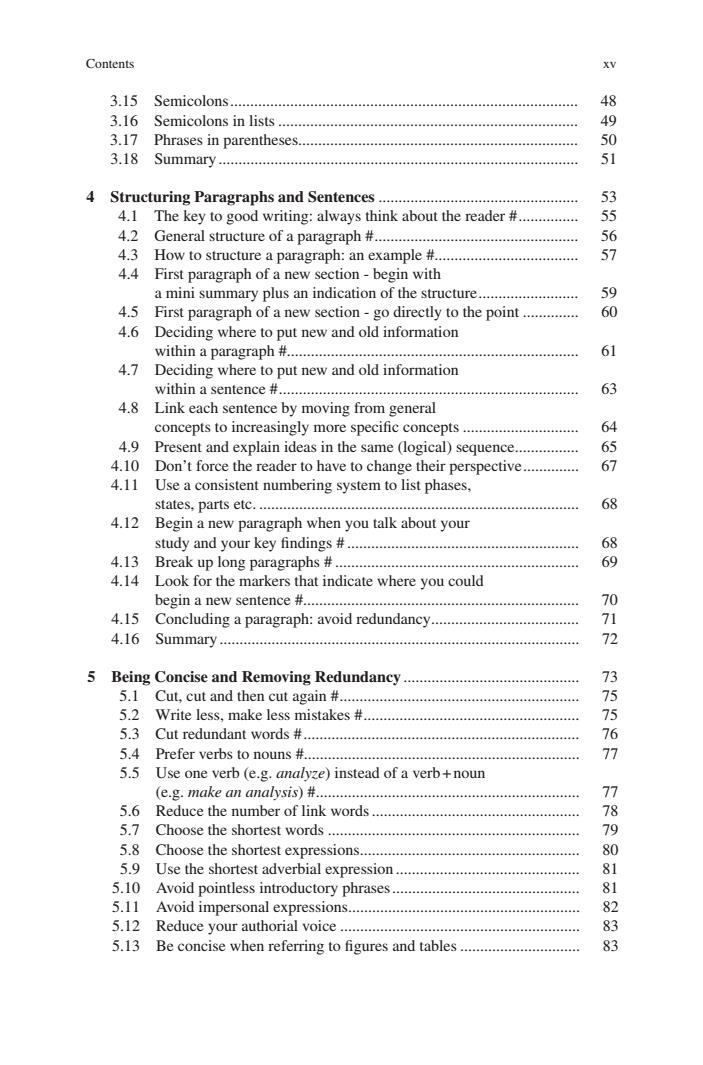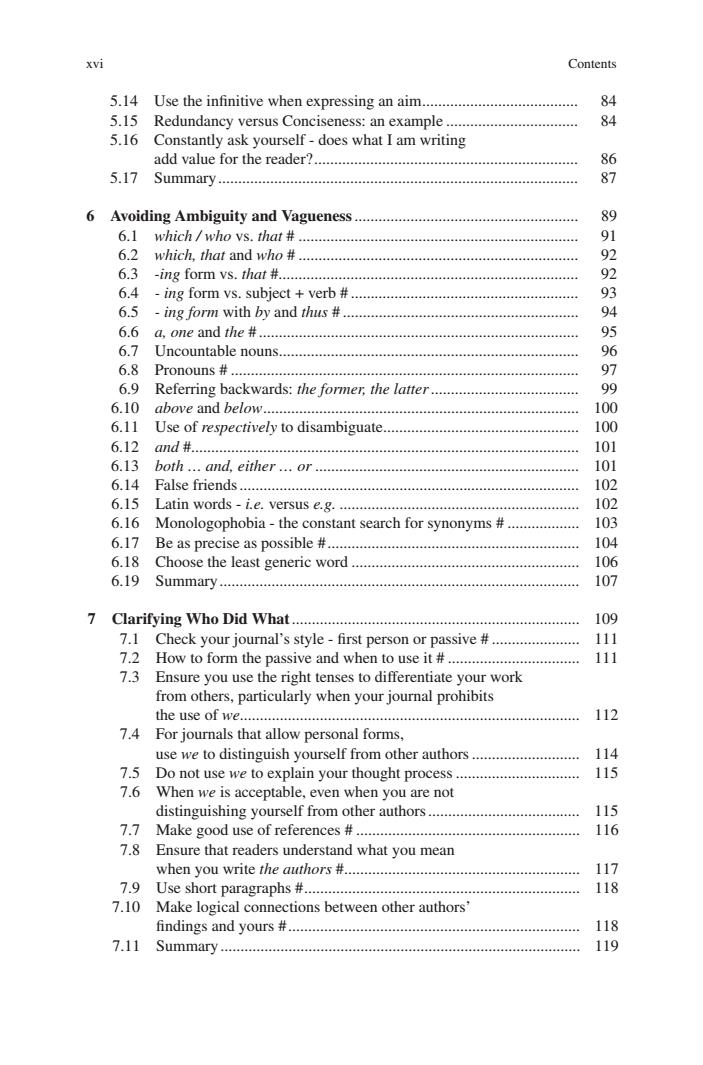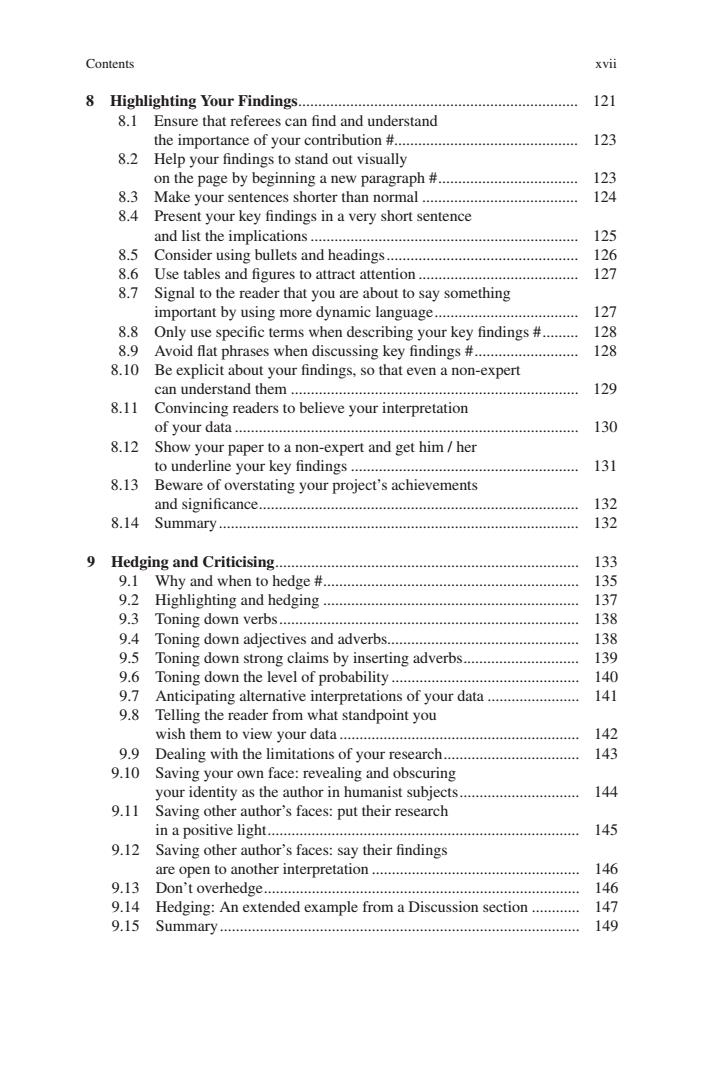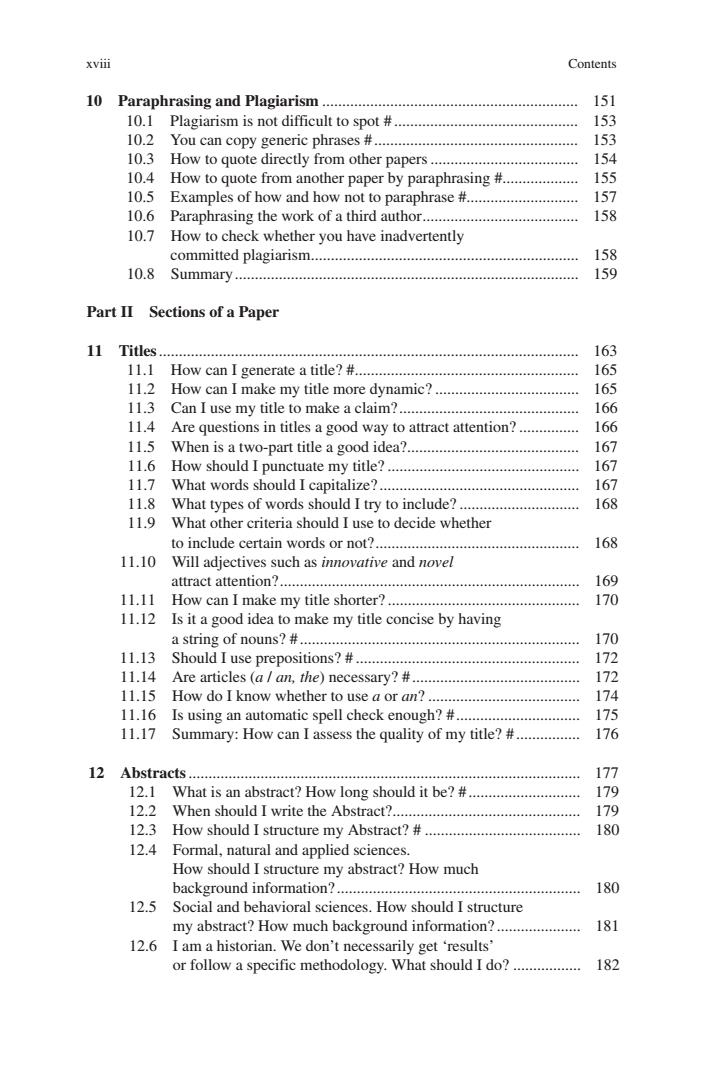
Contents XV 3.15 Semicolons........ 48 3.16 Semicolons in lists… 49 3.17 Phrases in parentheses........... 50 3.18 Summary......... 51 4 Structuring Paragraphs and Sentences 444444444444444 53 4.1 The key to good writing:always think about the reader # 55 4.2 General structure of a paragraph #.... 56 4.3 How to structure a paragraph:an example #................. 57 4.4 First paragraph of a new section-begin with a mini summary plus an indication of the structure................ 59 4.5 First paragraph of a new section-go directly to the point ..... 60 4.6 Deciding where to put new and old information Within a paragraph. 61 4.7 Deciding where to put new and old information within a sentence #.................. 63 4.8 Link each sentence by moving from general concepts to increasingly more specific concepts.......... 64 4.9 Present and explain ideas in the same (logical)sequence..... 65 4.10 Don't force the reader to have to change their perspective.............. 67 4.11 Use a consistent numbering system to list phases, states,parts etc. 68 4.12 Begin a new paragraph when you talk about your study and your key findings#.................... 68 4.13 Break up long paragraphs #............ 69 4.14 Look for the markers that indicate where you could begin a new sentence 70 4.15 Concluding a paragraph:avoid redundancy...... 71 4.16 Summary 72 5 Being Concise and Removing Redundancy..................... 73 5.1 Cut,cut and then cut again #........... 75 5.2 Write less,make less mistakes #.... 75 5.3 Cut redundant words#.. 76 5.4 Prefer verbs to nouns #............ 77 5.5 Use one verb (e.g.analyze)instead of a verb+noun e.g.make an analysis). 77 5.6 Reduce the number of link words.. 78 5.7 Choose the shortest words 79 5.8 Choose the shortest expressions......................... 80 5.9 Use the shortest adverbial expression.... 81 5.10 Avoid pointless introductory phrases.. 81 5.11 Avoid impersonal expressions. 82 5.12 Reduce your authorial voice...... 83 5.13 Be concise when referring to figures and tables ........................ 83
Contents xv 3.15 Semicolons....................................................................................... 48 3.16 Semicolons in lists ........................................................................... 49 3.17 Phrases in parentheses...................................................................... 50 3.18 Summary.......................................................................................... 51 4 Structuring Paragraphs and Sentences .................................................. 53 4.1 The key to good writing: always think about the reader #............... 55 4.2 General structure of a paragraph #................................................... 56 4.3 How to structure a paragraph: an example #.................................... 57 4.4 First paragraph of a new section - begin with a mini summary plus an indication of the structure......................... 59 4.5 First paragraph of a new section - go directly to the point .............. 60 4.6 Deciding where to put new and old information within a paragraph #......................................................................... 61 4.7 Deciding where to put new and old information within a sentence #........................................................................... 63 4.8 Link each sentence by moving from general concepts to increasingly more specific concepts ............................. 64 4.9 Present and explain ideas in the same (logical) sequence................ 65 4.10 Don’t force the reader to have to change their perspective.............. 67 4.11 Use a consistent numbering system to list phases, states, parts etc. ................................................................................ 68 4.12 Begin a new paragraph when you talk about your study and your key findings # .......................................................... 68 4.13 Break up long paragraphs # ............................................................. 69 4.14 Look for the markers that indicate where you could begin a new sentence #..................................................................... 70 4.15 Concluding a paragraph: avoid redundancy..................................... 71 4.16 Summary.......................................................................................... 72 5 Being Concise and Removing Redundancy ............................................ 73 5.1 Cut, cut and then cut again #............................................................ 75 5.2 Write less, make less mistakes #...................................................... 75 5.3 Cut redundant words #..................................................................... 76 5.4 Prefer verbs to nouns #..................................................................... 77 5.5 Use one verb (e.g. analyze) instead of a verb+noun (e.g. make an analysis) #.................................................................. 77 5.6 Reduce the number of link words.................................................... 78 5.7 Choose the shortest words ............................................................... 79 5.8 Choose the shortest expressions....................................................... 80 5.9 Use the shortest adverbial expression .............................................. 81 5.10 Avoid pointless introductory phrases............................................... 81 5.11 Avoid impersonal expressions.......................................................... 82 5.12 Reduce your authorial voice ............................................................ 83 5.13 Be concise when referring to figures and tables .............................. 83

xvi Contents 5.14 Use the infinitive when expressing an aim...... 84 5.15 Redundancy versus Conciseness:an example................ 84 5.16 Constantly ask yourself-does what I am writing add value for the reader?........... 86 5.17 Summary. 87 6 Avoiding Ambiguity and Vagueness.... 89 6.1 which /who vs.that#. 91 6.2 which,that and who#. 92 6.3 -ing form vs.that #............. 92 6.4 -ing form vs.subject +verb# 93 6.5-ing form with by and thus. 94 6.6a,one and the#… 95 6.7 Unc0 untable n0unS.… 96 6.8 Pronouns #............... 97 6.9 Referring backwards:the former,the latter.... 99 6.10 above and below............ 100 6.11 Use of respectively to disambiguate... 100 6.12and#.… 101 6.13both…and,either.…0r.… 101 6.14 False friends. 102 6.15 Latin words-i.e.versus e.g............... 4444444444444 102 6.16 Monologophobia-the constant search for synonyms #......... 103 6.17 Be as precise as possible #..... 44444444444444444444444444444444444444444444444444444444 104 6.18 Choose the least generic word.... 106 6.l9 Summary… 107 7 Clarifying Who Did What.. 109 7.1 Check your journal's style-first person or passive #.................. 111 7.2 How to form the passive and when to use it #...................... 111 7.3 Ensure you use the right tenses to differentiate your work from others,particularly when your journal prohibits the use0fwe.… 112 7.4 For journals that allow personal forms, use we to distinguish yourself from other authors............... 114 7.5 Do not use we to explain your thought process................. 115 7.6 When we is acceptable,even when you are not distinguishing yourself from other authors.. 115 7.7 Make good use of references# 116 7.8 Ensure that readers understand what you mean when you write the authors 117 7.9 Use short paragraphs 118 7.10 Make logical connections between other authors' findings and yours #..... 118 7.11 Summary… 119
xvi Contents 5.14 Use the infinitive when expressing an aim....................................... 84 5.15 Redundancy versus Conciseness: an example ................................. 84 5.16 Constantly ask yourself - does what I am writing add value for the reader?.................................................................. 86 5.17 Summary.......................................................................................... 87 6 Avoiding Ambiguity and Vagueness........................................................ 89 6.1 which / who vs. that # ...................................................................... 91 6.2 which, that and who # ...................................................................... 92 6.3 -ing form vs. that #........................................................................... 92 6.4 - ing form vs. subject + verb # ......................................................... 93 6.5 - ing form with by and thus # ........................................................... 94 6.6 a, one and the # ................................................................................ 95 6.7 Uncountable nouns........................................................................... 96 6.8 Pronouns # ....................................................................................... 97 6.9 Referring backwards: the former, the latter..................................... 99 6.10 above and below............................................................................... 100 6.11 Use of respectively to disambiguate................................................. 100 6.12 and #................................................................................................. 101 6.13 both … and, either … or .................................................................. 101 6.14 False friends..................................................................................... 102 6.15 Latin words - i.e. versus e.g. ............................................................ 102 6.16 Monologophobia - the constant search for synonyms # .................. 103 6.17 Be as precise as possible #............................................................... 104 6.18 Choose the least generic word ......................................................... 106 6.19 Summary.......................................................................................... 107 7 Clarifying Who Did What........................................................................ 109 7.1 Check your journal’s style - first person or passive # ...................... 111 7.2 How to form the passive and when to use it # ................................. 111 7.3 Ensure you use the right tenses to differentiate your work from others, particularly when your journal prohibits the use of we..................................................................................... 112 7.4 For journals that allow personal forms, use we to distinguish yourself from other authors........................... 114 7.5 Do not use we to explain your thought process ............................... 115 7.6 When we is acceptable, even when you are not distinguishing yourself from other authors...................................... 115 7.7 Make good use of references # ........................................................ 116 7.8 Ensure that readers understand what you mean when you write the authors #........................................................... 117 7.9 Use short paragraphs #..................................................................... 118 7.10 Make logical connections between other authors’ findings and yours #......................................................................... 118 7.11 Summary.......................................................................................... 119

Contents xvii 8 Highlighting Your Findings.................. 121 8.1 Ensure that referees can find and understand the importance of your contribution#.......... 123 8.2 Help your findings to stand out visually on the page by beginning a new paragraph #.......... 123 8.3 Make your sentences shorter than normal ..................... 124 8.4 Present your key findings in a very short sentence and list the implications. 125 8.5 Consider using bullets and headings..... 126 8.6 Use tables and figures to attract attention.......... 127 8.7 Signal to the reader that you are about to say something important by using more dynamic language............... 127 8.8 Only use specific terms when describing your key findings #........ 128 89 Avoid flat phrases when discussing key findings #...................... 128 8.10 Be explicit about your findings,so that even a non-expert can understand them .................. 129 8.11 Convincing readers to believe your interpretation 0fy0 ur data… 130 8.12 Show your paper to a non-expert and get him/her to underline your key findings. 131 8.13 Beware of overstating your project's achievements and significance...... 132 8.14 Summary... 132 9 Hedging and Criticising........ 133 9.1 Why and when to hedge#. 135 9.2 Highlighting and hedging 137 9.3 Toning down verbs.. 138 9.4 Toning down adjectives and adverbs.... 138 9.5 Toning down strong claims by inserting adverbs............................ 139 9.6 Toning down the level of probability.................. 140 9.7 Anticipating alternative interpretations of your data 141 9.8 Telling the reader from what standpoint you wish them to view your data........... 44444444 142 9.9 Dealing with the limitations of your research..... 143 9.10 Saving your own face:revealing and obscuring your identity as the author in humanist subjects................... 144 9.11 Saving other author's faces:put their research inap0 sitive light… 145 9.12 Saving other author's faces:say their findings are open to another interpretation......... 146 9.l3D0n't0 verhedge… 146 9.14 Hedging:An extended example from a Discussion section ........... 147 9.15 Summary..... 149
Contents xvii 8 Highlighting Your Findings...................................................................... 121 8.1 Ensure that referees can find and understand the importance of your contribution #.............................................. 123 8.2 Help your findings to stand out visually on the page by beginning a new paragraph #................................... 123 8.3 Make your sentences shorter than normal ....................................... 124 8.4 Present your key findings in a very short sentence and list the implications................................................................... 125 8.5 Consider using bullets and headings................................................ 126 8.6 Use tables and figures to attract attention ........................................ 127 8.7 Signal to the reader that you are about to say something important by using more dynamic language.................................... 127 8.8 Only use specific terms when describing your key findings #......... 128 8.9 Avoid flat phrases when discussing key findings #.......................... 128 8.10 Be explicit about your findings, so that even a non-expert can understand them ........................................................................ 129 8.11 Convincing readers to believe your interpretation of your data ...................................................................................... 130 8.12 Show your paper to a non-expert and get him / her to underline your key findings ......................................................... 131 8.13 Beware of overstating your project’s achievements and significance................................................................................ 132 8.14 Summary.......................................................................................... 132 9 Hedging and Criticising............................................................................ 133 9.1 Why and when to hedge #................................................................ 135 9.2 Highlighting and hedging ................................................................ 137 9.3 Toning down verbs........................................................................... 138 9.4 Toning down adjectives and adverbs................................................ 138 9.5 Toning down strong claims by inserting adverbs............................. 139 9.6 Toning down the level of probability ............................................... 140 9.7 Anticipating alternative interpretations of your data ....................... 141 9.8 Telling the reader from what standpoint you wish them to view your data ............................................................ 142 9.9 Dealing with the limitations of your research.................................. 143 9.10 Saving your own face: revealing and obscuring your identity as the author in humanist subjects.............................. 144 9.11 Saving other author’s faces: put their research in a positive light.............................................................................. 145 9.12 Saving other author’s faces: say their findings are open to another interpretation .................................................... 146 9.13 Don’t overhedge............................................................................... 146 9.14 Hedging: An extended example from a Discussion section ............ 147 9.15 Summary.......................................................................................... 149

xviii Contents 10 Paraphrasing and Plagiarism. 151 10.1 Plagiarism is not difficult to spot# 153 10.2 You can copy generic phrases# 153 10.3 How to quote directly from other papers.... 154 10.4 How to quote from another paper by paraphrasing #.................. 155 10.5 Examples of how and how not to paraphrase #... 4444444444444444444444 157 10.6 Paraphrasing the work of a third author......... 158 10.7 How to check whether you have inadvertently committed plagiarism. 158 10.8 Summary....... 159 Part II Sections of a Paper 11 Titles.… 163 11.1 How can I generate a title?# 165 11.2 How can I make my title more dynamic?............ 165 11.3 Can I use my title to make a claim?..... 166 11.4 Are questions in titles a good way to attract attention?............... 166 11.5 When is a two-part title a good idea?.... 167 11.6 How should I punctuate my title?. 167 11.7 What words should I capitalize?.............. 167 11.8 What types of words should I try to include?......... 168 11.9 What other criteria should I use to decide whether to include certain words or not?............... 168 11.10 Will adjectives such as innovative and novel attract attention2… 169 11.11 How can I make my title shorter?..... 170 11.12 Is it a good idea to make my title concise by having a string0fn0uns?#… 170 11.13 Should I use prepositions?#. 172 11.14 Are articles (a/an,the)necessary?#.............. 172 11.15 How do I know whether to use a or an?..... 174 11.16 Is using an automatic spell check enough?#..................... 175 11.17 Summary:How can I assess the quality of my title?#................ 176 12 Abstracts. 177 12.1 What is an abstract?How long should it be?#................ 179 12.2 When should I write the Abstract?..... 179 12.3 How should I structure my Abstract?#............ 180 12.4 Formal,natural and applied sciences. How should I structure my abstract?How much background information?. 180 12.5 Social and behavioral sciences.How should I structure my abstract?How much background information?............... 181 12.6 I am a historian.We don't necessarily get 'results or follow a specific methodology.What should I do?................. 182
xviii Contents 10 Paraphrasing and Plagiarism ................................................................ 151 10.1 Plagiarism is not difficult to spot # .............................................. 153 10.2 You can copy generic phrases #................................................... 153 10.3 How to quote directly from other papers..................................... 154 10.4 How to quote from another paper by paraphrasing #................... 155 10.5 Examples of how and how not to paraphrase #............................ 157 10.6 Paraphrasing the work of a third author....................................... 158 10.7 How to check whether you have inadvertently committed plagiarism................................................................... 158 10.8 Summary...................................................................................... 159 Part II Sections of a Paper 11 Titles......................................................................................................... 163 11.1 How can I generate a title? #........................................................ 165 11.2 How can I make my title more dynamic? .................................... 165 11.3 Can I use my title to make a claim?............................................. 166 11.4 Are questions in titles a good way to attract attention? ............... 166 11.5 When is a two-part title a good idea?........................................... 167 11.6 How should I punctuate my title? ................................................ 167 11.7 What words should I capitalize? .................................................. 167 11.8 What types of words should I try to include? .............................. 168 11.9 What other criteria should I use to decide whether to include certain words or not?................................................... 168 11.10 Will adjectives such as innovative and novel attract attention?........................................................................... 169 11.11 How can I make my title shorter? ................................................ 170 11.12 Is it a good idea to make my title concise by having a string of nouns? #...................................................................... 170 11.13 Should I use prepositions? # ........................................................ 172 11.14 Are articles (a / an, the) necessary? #.......................................... 172 11.15 How do I know whether to use a or an? ...................................... 174 11.16 Is using an automatic spell check enough? #............................... 175 11.17 Summary: How can I assess the quality of my title? # ................ 176 12 Abstracts.................................................................................................. 177 12.1 What is an abstract? How long should it be? #............................ 179 12.2 When should I write the Abstract?............................................... 179 12.3 How should I structure my Abstract? # ....................................... 180 12.4 Formal, natural and applied sciences. How should I structure my abstract? How much background information? ............................................................. 180 12.5 Social and behavioral sciences. How should I structure my abstract? How much background information? ..................... 181 12.6 I am a historian. We don’t necessarily get ‘results’ or follow a specific methodology. What should I do? ................. 182

Contents xix 12.7 I am writing a review.How should I structure my Abstract? 183 12.8 How should I begin my Abstract?. 184 12.9 What style should I use:personal or impersonal?.......... 185 12.10 What tenses should I use?. 186 12.11 How do I write a structured abstract?......... 187 12.12 How do I write an abstract for a conference?.... 188 12.13 How do I write an abstract for a work in progress that will be presented at a conference?.. 189 12.14 How should I select my key words?How often should I repeat them?.… 190 12.15 Should I mention any limitations in my research?...................... 190 12.16 What should I not mention in my Abstract?............ 191 12.17 How can I ensure that my Abstract has maximum impact?......... 191 12.18 What are some of the typical characteristics of poor abstracts?#....... 191 12.19 Summary:How can I assess the quality of my Abstract?#........ 193 13 Introduction....... 195 13.1 How should I structure the Introduction?#.......................... 197 13.2 How should I begin my Introduction?#............................. 197 13.3 How should I structure the rest of the Introduction? 199 13.4 I do not work in the field of a 'hard'science. Are there any other ways of beginning an Introduction?............. 200 13.5 What typical phrases should I avoid in my Introduction?............ 201 13.6 How does an Introduction differ from an Abstract?................... 201 13.7 What tenses should I use?#... 203 13.8 How should I outline the structure of my paper?...................... 204 13.9 Summary:How can I assess the quality of my Introduction?.. 205 14 Review of the Literature.......... 207 14.1 How should I structure my Review of the Literature?#............. 209 14.2 How should I begin my literature review? How can I structure it to show the progress through the years'?#.… 209 14.3 What is the clearest way to refer to other authors? Should I focus on the authors or their ideas?#..... 210 14.4 What tenses should I use?#. 211 14.5 How can I reduce the amount I write when reporting the literature?… 213 14.6 How can I talk about the limitations of previous work and the novelty of my work in a constructive and diplomatic way?........ 214 14.7 Summary:How can I assess the quality of my Literature Review?#....... 215
Contents xix 12.7 I am writing a review. How should I structure my Abstract? ................................................................................ 183 12.8 How should I begin my Abstract?................................................ 184 12.9 What style should I use: personal or impersonal? ....................... 185 12.10 What tenses should I use? ............................................................ 186 12.11 How do I write a structured abstract? .......................................... 187 12.12 How do I write an abstract for a conference? .............................. 188 12.13 How do I write an abstract for a work in progress that will be presented at a conference? ........................................ 189 12.14 How should I select my key words? How often should I repeat them?............................................................................... 190 12.15 Should I mention any limitations in my research?....................... 190 12.16 What should I not mention in my Abstract? ................................ 191 12.17 How can I ensure that my Abstract has maximum impact?......... 191 12.18 What are some of the typical characteristics of poor abstracts? # ...................................................................... 191 12.19 Summary: How can I assess the quality of my Abstract? #......... 193 13 Introduction............................................................................................. 195 13.1 How should I structure the Introduction? # ................................. 197 13.2 How should I begin my Introduction? # ...................................... 197 13.3 How should I structure the rest of the Introduction? # ................ 199 13.4 I do not work in the field of a ‘hard’ science. Are there any other ways of beginning an Introduction?............. 200 13.5 What typical phrases should I avoid in my Introduction?............ 201 13.6 How does an Introduction differ from an Abstract? .................... 201 13.7 What tenses should I use? #......................................................... 203 13.8 How should I outline the structure of my paper?......................... 204 13.9 Summary: How can I assess the quality of my Introduction? #................................................................... 205 14 Review of the Literature......................................................................... 207 14.1 How should I structure my Review of the Literature? #.............. 209 14.2 How should I begin my literature review? How can I structure it to show the progress through the years? #..................................................................... 209 14.3 What is the clearest way to refer to other authors? Should I focus on the authors or their ideas? #............................ 210 14.4 What tenses should I use? #......................................................... 211 14.5 How can I reduce the amount I write when reporting the literature? ............................................................................... 213 14.6 How can I talk about the limitations of previous work and the novelty of my work in a constructive and diplomatic way? .................................................................... 214 14.7 Summary: How can I assess the quality of my Literature Review? #.......................................................... 215